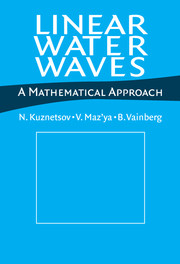Book contents
- Frontmatter
- Contents
- Preface
- Introduction: Basic Theory of Surface Waves
- 1 Time-Harmonic Waves
- 2 Ship Waves on Calm Water
- 3 Unsteady Waves
- 9 Submerged Obstacles: Existence and Properties of Velocity Potentials
- 10 Waves Caused by Rapidly Stabilizing and High-Frequency Disturbances
- Bibliography
- Name Index
- Subject Index
10 - Waves Caused by Rapidly Stabilizing and High-Frequency Disturbances
from 3 - Unsteady Waves
Published online by Cambridge University Press: 14 October 2009
- Frontmatter
- Contents
- Preface
- Introduction: Basic Theory of Surface Waves
- 1 Time-Harmonic Waves
- 2 Ship Waves on Calm Water
- 3 Unsteady Waves
- 9 Submerged Obstacles: Existence and Properties of Velocity Potentials
- 10 Waves Caused by Rapidly Stabilizing and High-Frequency Disturbances
- Bibliography
- Name Index
- Subject Index
Summary
Results presented in Chapter 9 provide no details of the transient behavior of flows and do not yield direct hydrodynamic corollaries. However, there are situations in which information about developing waves in time can be extracted so that it leads to specific properties of hydrodynamic characteristics. In particular, an asymptotic analysis allows us to do this at least for two classes of disturbances. One of these classes constitutes rapidly stabilizing disturbances (this class includes brief disturbances as an important subclass), and the second class is formed by high-frequency disturbances. Both of these classes can be treated by using the same technique of two-scale asymptotic expansions for velocity potentials. The latter allows us to derive principal terms in asymptotics of some hydrodynamic characteristics.
Rapidly Stabilizing Surface Disturbances
In this section we are concerned with the effect of rapidly stabilizing disturbances on magnitudes characterizing unsteady water waves. For this purpose we consider several initial-boundary value problems describing waves caused by surface and underwater disturbances. The main example of the first kind is given by a pressure system applied to the free surface at the initial moment and rapidly stabilizing to a given distribution (a particular case is an impulsive pressure system). Underwater disturbances are presented by a source having a strength rapidly stabilizing in time to a constant value, and a rapidly stabilizing bottom movement. Complete asymptotic expansions in powers of a nondimensional small duration of disturbance are constructed for velocity potentials.
- Type
- Chapter
- Information
- Linear Water WavesA Mathematical Approach, pp. 435 - 484Publisher: Cambridge University PressPrint publication year: 2002



